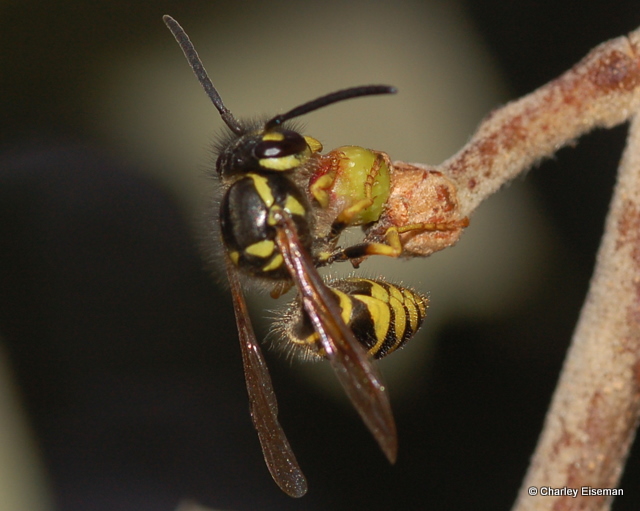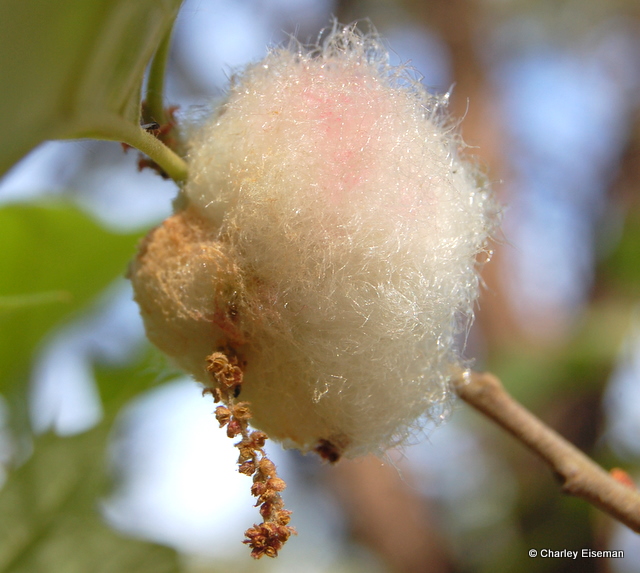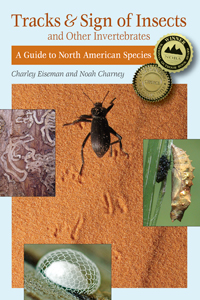Last month Noah Charney, Sydne Record, and I spent four days surveying the island of Nantucket, Massachusetts for galls, leaf mines, and other species-specific invertebrate signs. The Nantucket Biodiversity Initiative had put out a request for proposals for research that would improve knowledge of the island’s biodiversity, and when I discovered that just twelve species of gall wasp (Cynipidae), seven species of gall midge (Cecidomyiidae), and a single leaf-mining moth had been documented there, I was pretty sure we could do better. Sure enough, on the first morning we were there, I only had to cross the small parking lot outside the condo where we were staying to add two leaf-mining moths to the list.
We spent that first day at Squam Swamp, one of the only forested areas on the island, photographing things we recognized and collecting those we didn’t. I’ve been working through all our photos and field notes, and so far have identified fifty or so species. Some of these identifications have come easily, and some have involved extensive digging in the literature. The example I’m about to share illustrates both why I find galls so fascinating and, I think, why so few people study them.
As we were leaving Squam Swamp, we noticed a yellowjacket that seemed unusually interested in one little spot on an oak twig. On closer inspection, it was slurping from a tiny gall protruding from the side of a developing acorn.
I knew there were honeydew-secreting wasp galls, but had never seen one in action before. The idea with these is that they attract ants and wasps, and these relatively large, aggressive insects deter tiny parasitoid wasps from showing up and laying their eggs in the galls. So the gall wasps’ genetic engineering of the oak tree is so sophisticated that it not only causes these spherical structures to emerge from the sides of acorns, surrounding their developing offspring and providing them with shelter and all the food they need to complete their development, but it programs them to leak a sweet, sugary substance–not something we normally associate with oaks–to entice other insects to provide additional protection.
My main reference for figuring out what these things are is Lewis Weld’s Cynipid Galls of the Eastern United States, privately published in 1959. This book has a nice redundant organization, with one section that lets you look up a species of oak and see all the associated galls grouped by the part of the tree they grow on; another section with all the illustrations, interspersed with notes cataloging the natural history and host lists for each gall (whether or not it is illustrated), again arranged according to gall type and location on the plant; and a final succinct list of the species arranged by gall type and location. The maddening thing (apart from the fact that it is almost impossible to find a copy of this book) is that none of these three sections is complete, and each one seems to include some unique information, so I end up having to check each one, making a master summary of all the information for each species, which I can then check against the gall in question. I get the sense that it’s all typewritten, and that at some point he had to just leave out things that were accidentally omitted rather than type everything out again. Oh, and the photographs are, of course, in black and white and often don’t show enough detail.
These little galls protruding between an acorn and its cap are called “pip galls,” and all of them are in the genus Callirhytis. Weld’s descriptions of them are pretty vague, and most of the photographs seem to show unmodified acorns. Fortunately, E. P. Felt’s Plant Galls and Gall Makers (1940) has better descriptions of them; unfortunately it does not include all the species. This book, incidentally, is a great reference but a) it is out of print (though reprinted in 2001 by an Indian publisher–not sure how legal that edition is), b) many (most?) of the names are out of date, c) there are quite a few misidentifications and other inaccuracies, d) the photos are no better than Weld’s (and in fact are often identical), and e) the photos and illustrations are sprinkled at random through the book.
Anyway, between the two references I’ve arrived at Callirhytis balanacea for this one–not to be confused with C. balanosa, C. balanoides, C. balanaspis, or C. balanopsis–because the other ones either form in the spring, don’t protrude so much from the acorn cap, are shaped differently, or don’t secrete honeydew. But putting a name on a gall is just the beginning of figuring out what’s going on with it.
In the process of identifying this gall, I came across Callirhytis quercusoperator. This species, too, makes pip galls; Felt describes these as “flattened, tooth-like or wedge-shaped galls on the outside of the acorn, the ends usually protruding more or less beyond the cupule, on black, red, scarlet, scrub, and Spanish oaks.” In his notes for this gall Weld states that “[t]he original material of this species was collected at Waterbury, Conn. Aug. 23, 1871 on Q. ilicifolia [scrub oak] during Riley’s visit to Bassett. Bassett kept his galls a year and rearing nothing threw them away. Riley kept his longer and the second spring reared the maker ‘just as the oak buds were bursting.’ His label bears the date Apr. 5, 1873. This established an alternation of generations in the [C]ynipidae.”
This anecdote reveals two things about the difficulty of studying gall wasps. One is that it can take more than a year for adults to emerge from their galls. Writing about cynipids in general, Weld states that “[o]ften two or more winters pass before the adults finally emerge.” I’m not sure what the record is, but I seem to remember a reference to some wasps lying dormant in galls for as long as seven years.
The other is this business about alternating generations. See, the adult wasps that emerge from Callirhytis quercusoperator acorn pip galls, however many springs after the galls first formed, are all females. They don’t need to mate; they simply fly to developing oak flowers (catkins) and lay eggs in them. The result is the “woolly catkin gall”:
In June or July, these catkin galls turn brown and the adults emerge. These adults include both males and females, which are short-lived: they mate, the females lay eggs in developing acorns, and they die. These, by the way, are not acorns developing from the generation of flowers from whose galls the wasps have just emerged. Acorns in the red oak group take 18 months to develop, and these pip galls (unlike the one pictured above) are initiated in year-old acorns, becoming evident in the fall when the acorns are nearly mature.
This is not an unusual life cycle for a gall wasp; in fact, most species are believed to have alternating generations, although in many cases the gall of only one of the generations is known. So although there are “only” 600 or so cynipid species producing galls on North American oaks, there may be twice that number of different galls. The complexity is further multiplied by the inquilines and parasitoids that occupy many (if not most) of the galls. Not only do these mean that the little wasp(s) that emerge from a gall may not belong to the species responsible for the gall; they also may modify the size and structure of the gall, as seen here. Incidentally, I have now had three different wasps emerge from those “round bullet galls,” and none of them have been cynipids. The other two, one of which seems to be a parasitoid of the other, are shown here.
So, needless to say, not every gall I found on Nantucket is getting identified to species. Just yesterday, though, a cynipid emerged from one of the ones I collected, which doesn’t seem to match any of the ones described by Weld. So my efforts just might end up adding something to the collective knowledge about these little wasps.







Another great, informative post, Charley! Your close-up photos of the yellowjacket and of the acorn bud stirred a memory of a photo that Lynette Schimming posted on BugGuide in 2005 of carpenter ants at an acorn bud of blackjack oak in North Carolina: http://bugguide.net/node/view/23684
Thanks for the link! I think I had seen that photo before but didn’t know what I was looking at at the time. Weld lists two acorn pip galls for blackjack oak, C. balanaspis and C. balanopsis; Felt describes the former as “deeply imbedded” and the latter as “mostly protruding,” so I think it is the latter. I’m now thinking my gall might be C. balanopsis too–Weld lists only Q palustris, Q. velutina, and Q. phellos as hosts for C. balanacea, but for C. balanopsis says “On Q. marilandica in autumn. Also on nearly all the red oaks.” Appearance-wise, the distinction is not entirely clear to me.
Pingback: Ant-attracting Galls | BugTracks
Thanks for the info…I have a very, very large oak in the yard that for the past three summer/fall seasons literally hums with the thrums of wasp and yellow jacket wings from sjn up to sun down and the ground is littered with acorn galls…I have been wondering what is going on because I had never witnessed such a phenomenal number and variety of wasps and yellow jackets crawling on and flying around the oak tree before and I have lived with this tree for nearly 20 years…thanks again
The wasps might also be attracted to honeydew dripping from treehoppers, as I observed (with a hover fly) here.